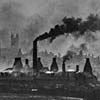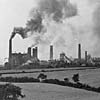

| Home page |
| Historical Overview |
The mining industry in North Staffordshire goes back far into the thirteenth century, when mines are referred to in the Tunstall Manorial Court Rolls. The North Staffordshire Coalfield comprises four mining areas: Goldsitch Moss, Shaffalong, Cheadle, and the Potteries. The Potteries coalfield covers an area of about 100 square miles, while the other three cover less than 30 square miles.
The coal industry gradually expanded due to demand from the pottery and iron industry. It was also due to the establishment of the new transport system, canals (1777) and later railways (1837).
The coal industry went from private small owners to big group ironmaster owners, to nationalisation in 1947, until the last deep mine (Silverdale) was closed in December 1998. All that remains to remind us of this human endeavour is a few derelict buildings and re-landscaped slag heaps.
The contribution of this once splendid industry, will always occupy an irreplaceable position in the industrial and social history of the area.
Click image or highlighted words below to go to that specific section.
 |
Potteries: As the Pottery industry expanded, the demand for coal increased accordingly. |
 |
Iron and Steel: Closely allied with coal was the iron industry. |